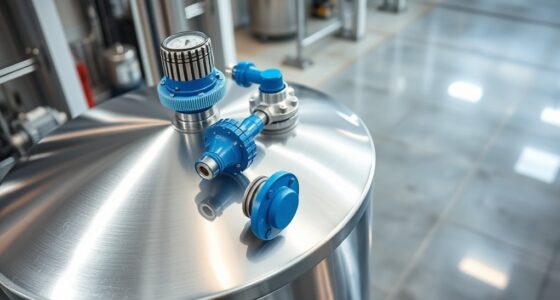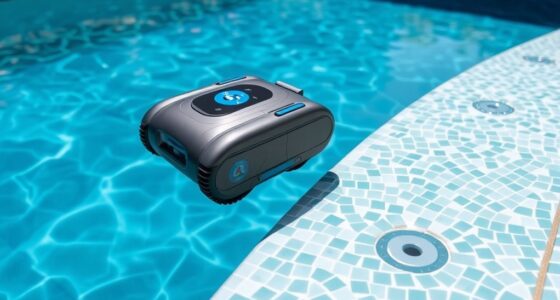To control water levels effectively, your system uses autofill valves that open when water drops below a set point and close once the desired level is reached. Sensors like float switches or ultrasonic devices provide real-time data, helping prevent overflows by triggering alarms or shut-offs when levels get too high. Proper maintenance and integration guarantee your system remains dependable and efficient. Keep exploring to discover how these components work together seamlessly.
Key Takeaways
- Autofill valves automatically regulate water levels by opening or closing based on sensor signals to prevent overflow or dry running.
- Sensors like float switches, ultrasonic, or capacitive devices monitor water levels precisely and trigger control actions.
- Overflow management includes sensors, alarms, and maintenance to detect and prevent water spills or system damage.
- Integration of sensors and valves ensures real-time adjustments, improving system reliability and efficiency.
- Regular inspection and maintenance of components optimize performance and extend system lifespan.
How Autofill Valves Maintain Optimal Water Levels

Have you ever wondered how tanks or pools keep their water levels steady without constant supervision? Autofill valves play a vital role in this process. When the water level drops below a set point, the valve automatically opens to let in more water. As the water rises, the valve closes once it reaches the desired level, preventing overflow. These valves are designed to respond quickly and reliably, ensuring your water system stays balanced. They operate mechanically or electronically, depending on the setup, and require minimal maintenance. Thanks to autofill valves, you don’t need to constantly monitor water levels or manually top off tanks. Instead, they work silently in the background, maintaining an ideal water level efficiently and automatically. Proper maintenance ensures these valves continue functioning effectively over time.
The Role of Sensors in Water Level Monitoring

Ever wondered how water levels are monitored with such precision? Sensors play a vital role in this process. They detect the water level in tanks or reservoirs, providing real-time data to control systems. There are different types of sensors, such as float switches, ultrasonic sensors, and capacitive sensors, each suited for specific applications. Float switches work mechanically, rising or falling with water, triggering a switch when a certain level is reached. Ultrasonic sensors use sound waves to measure distance to the water surface, offering non-contact measurement. Capacitive sensors detect changes in water’s electrical properties. These sensors continuously send data to your controller, enabling automatic adjustments. This real-time feedback ensures your water system maintains ideal levels without manual intervention. Additionally, integrating sensors with automation systems can significantly improve overall system efficiency and reliability.
Preventing Overflows With Effective Overflow Management

How can you prevent water overflows from disrupting your system? The key is implementing effective overflow management strategies. First, install high-quality overflow sensors that detect rising water levels early. Regularly inspect and maintain your pipes and valves to prevent blockages. Use alarms or automatic shut-off systems linked to sensors for instant response. Keep an eye on your water levels through clear indicators or monitoring systems. Additionally, set appropriate overflow thresholds to allow safe excess, preventing spills. Incorporating juice cleanse principles, such as routine checks and balanced thresholds, can help maintain system stability and prevent unintended overflows.
Frequently Asked Questions
How Long Do Autofill Valves Typically Last Before Replacement?
Autofill valves usually last between 5 to 10 years before you need to replace them. Factors like water quality, usage frequency, and maintenance can influence their lifespan. You should inspect the valve regularly for leaks, strange noises, or inconsistent filling. If you notice these signs or the valve isn’t functioning properly, it’s best to replace it promptly to avoid water damage or system malfunctions.
Can Sensors Malfunction Without Obvious Signs?
Yes, sensors can malfunction without obvious signs. You might notice no change in water levels or inconsistent filling, but the sensor could still be failing internally. Regularly check for irregular readings or water overflows, and test sensors periodically. If you suspect a malfunction, inspect wiring and connections, and consider replacing the sensor if issues persist. Staying vigilant helps prevent water damage and ensures your system runs smoothly.
Are There Energy Efficiency Benefits to Automatic Water Level Control?
Imagine a water system as a smart, efficient engine, saving energy with automatic controls. You benefit from reduced water waste and lower energy bills, thanks to sensors that optimize fill levels. By preventing overflows and unnecessary water heating, you conserve power. These systems operate seamlessly in the background, helping you save energy without extra effort, making your water management more sustainable and cost-effective.
What Maintenance Is Required for Overflow Systems?
You need to regularly inspect your overflow systems for any signs of damage, corrosion, or debris buildup. Make sure the overflow pipe isn’t clogged and that it functions properly by testing it periodically. Clean the overflow area to prevent blockages, and replace any worn or damaged parts promptly. Proper maintenance guarantees your overflow system works efficiently, preventing water damage and costly repairs in the future.
How Do Different Water Sources Affect Autofill System Performance?
You might think your autofill system is foolproof, but different water sources can actually make it work harder. Hard water causes mineral buildup, clogging sensors and valves, while untreated water with debris can trigger false readings or damage components. Even clean, treated water can suffer from fluctuating pressure or mineral deposits over time. So, you need to monitor and maintain your system regularly, especially if your water source varies.
Conclusion
Think of your water system as a delicate dance—each component working in harmony to keep everything flowing smoothly. When you install autofill valves and sensors, you’re like a skilled conductor ensuring the rhythm stays perfect. I once saw a tank overflow because of neglected sensors, a reminder of how vital proper control is. By understanding and maintaining these systems, you prevent messy overflows and keep your water levels just right—like a well-choreographed performance.










